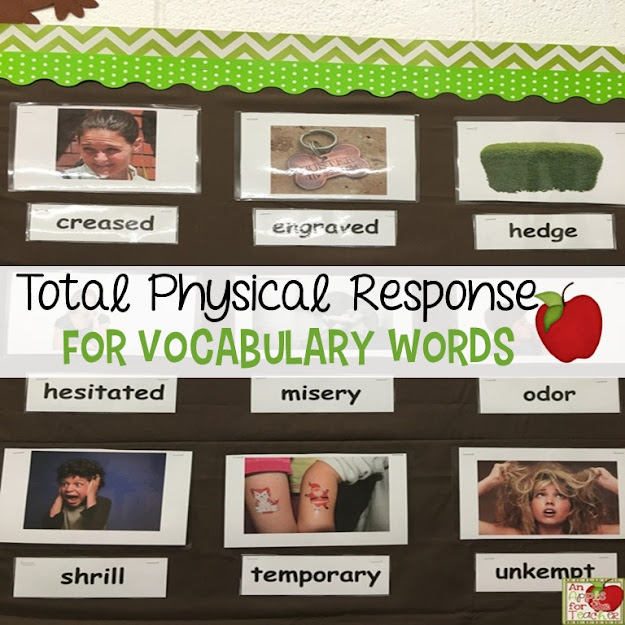I have had the great opportunity of being able to work with several ELL teachers who have pushed in my class to co-teach. One technique I have used with English Language Learners for learning vocabulary words is Total Physical Response. The best part? It works for ALL students!
What is Total Physical Response?
Total Physical Response (TPR) is a strategy or method of teaching language or vocabulary concepts to students using physical movement to react to verbal input.
Why Use Total Physical Response?
Total Physical Response mimics the way students learn their first language as infants, so, it is non-threatening. It lowers students inhibitions and stress levels. Having all students participate makes the English Language Learners not feel singled out.
How can teachers use Total Physical Response Strategies in the Classroom?
Step 1: Prepare.
Select the vocabulary words that you are going to choose. I often pull words in a text we are going to read that I know students might struggle with. This could include subject specific words such as area in math or words that are not commonly used such as accurate.
Gather any equipment, props, or pictures (often referred to as realia) that you will need to illustrate the meaning of the words you have chosen.
Step 2: Teacher Modeling.
Say the new vocabulary word out loud for the students. I like to have the word written or typed out on a card that will later go on our word wall. This allows the students to make a connection between the written and oral word.
As you say the word, use gestures, facial expressions, body movements, or props to define the word as you say it.
Step 3: Student Modeling.
Have student volunteers mimic the same movements you made as you say the vocabulary word out loud.
Step 4: Student Participation.
Have all students mimic the movements as they say the vocabulary word out loud. I like to use the Whole Brain Teaching method of Teach Okay for this.
Step 5: Repetition and Practice.
This is probably the most important step, so don't forget to use the words often! Review and practice words with students multiple times to ensure learning. Recycle the words into future lessons so that students have repeated practice and multiple exposures to the new word.
I often give my students bonus team points when they find the word in their reading or use it in their writing. They LOVE finding them, and it encourages the use of their new vocabulary words.
More Total Physical Response Strategy Resources:
Here is another great video of the Total Physical Response Strategy in action. I love the idea of having students create their own motions!
An Introduction to Total Physical Response (and four activities to try)
Have you used Total Physical Response in your classroom? I would love to hear about it in the comments below!





Great techniques!
ReplyDeleteOh this is a really great method! I need to do more research on it!
ReplyDeleteGreat way to increase language skills!
ReplyDeleteI think this is kind of the method that lively letters uses to teach letter sounds, there are hand motions involved and it really helps my 4 year old remember the sound.
ReplyDeleteI have used this in my classroom in the past and it really does help.
ReplyDeleteGreat strategy!
ReplyDeleteI am an ENL teacher, and these are great tips for teachers who work with ELLs. As our students who speak a language other than English as their first and/or primary language grows, every teacher will eventually teach an ELL.
ReplyDeleteGreat way to reinforce vocabulary!
ReplyDeleteWhat a wonderful strategy! I have actually not heard about this until I read your post! Thank you for sharing!
ReplyDeleteI love incorporating multi sensory approaches for increased engagement and learning!
ReplyDeleteI am totally going to use this strategy. I believe is fun and natural way to learn a word using body to create a whole experience!
ReplyDeleteThis is a great way to teach language skills. I work with special education students and they would benefit from this method of teaching.
ReplyDeletesoo good
ReplyDeleteI teach Special Education. These are great tips.
ReplyDeleteYes I have used something similar to this before. Great post!
ReplyDeleteFrom a homeschooling mom: thank you for your post.
ReplyDeleteI have been interested in learning more about TPR- thank you.
ReplyDeleteThis is perfect for my Spanish vocabulary lessons! :)
ReplyDeleteI have used this some tricky vocabulary! I use WBT strategies to structure how they learn the TPR.
ReplyDeleteClever concept! Thanks for sharing.
ReplyDeleteCan you recommend a book as a resource to learn more about TPR? I didn't see one mentioned in the post but I could have missed it.
ReplyDeleteIt was perfect for Spanish lessons!
ReplyDeleteawesome method!!
ReplyDeleteGreat tips!
ReplyDeleteThis is now one of my favorites! :)
ReplyDeleteSo glad I found this site!
ReplyDeleteThis is perfect for my special ed kiddos, most of whom do not speak English at home & are reticent to practice their English for fear of making a mistake!
ReplyDeleteAwesome, thank you for this!
ReplyDeleteThis looks like a great strategy for Special Education students.
ReplyDeleteGreat step by step! Thanks for hard work, and sharing!
ReplyDeleteOne of my children I am homeschooling has a LD and this is such a big help thank you!
ReplyDelete